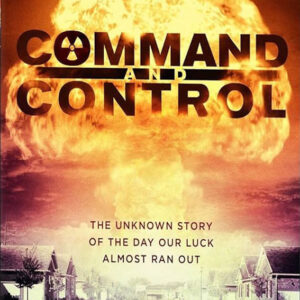calsfoundation@cals.org
Command and Control
Command and Control: Nuclear Weapons, the Damascus Accident, and the Illusion of Safety is a 2013 book by investigative journalist Eric Schlossser that explores the history of the United States’ nuclear weapons, efforts to control them, and accidents involving them, focusing particularly on the September 1980 Titan II Missile explosion in Arkansas. The book was the basis for a 2016 documentary film directed by Robert Kenner. Author Eric Schlosser previously wrote the New York Times bestsellers Fast Food Nation (2001) and Reefer Madness (2003).
The 632-page Command and Control, published by Penguin Press, explored the United States’ development of nuclear weapons and national policy regarding them from their origins in World War II into the twenty-first century. It also documented a dizzying number of accidents and near-disasters that accompanied the nuclear weapons industry, dating from Canadian physicist Louis Slotin’s fatal exposure to radiation in 1946 to a series of nuclear bomber crashes and accidents, including the accidental dropping of a Mark 6 atomic bomb in the yard of a South Carolina farmhouse in 1958 and a 1961 incident in North Carolina in which a B-52 bomber exploded and every safety mechanism in its hydrogen bomb payload failed with the exception of a simple switch.
Arkansas is the focus of much of the book, including the August 9, 1965, Titan II Missile accident at Launch Complex 373-4 near Searcy (White County) in which fifty-three civilian workers were killed in a flash fire in the deadliest incident in any U.S. nuclear weapons facility. The primary incident investigated in Command and Control, however, is the September 19, 1980, explosion at Launch Complex 374-7 north of Damascus (Van Buren and Faulkner counties). Schlosser worked not only from government documentary materials and interviews with military personnel involved in the incident, but also from extensive interviews with Arkansas civilians and law-enforcement personnel who witnessed the events. The book provides an almost minute-by-minute account of the Titan II missile explosion from the moment the rocket’s exterior was pierced by a fallen wrench socket through its massive explosion and into the chaotic aftermath.
While Command and Control is largely written with the detachment of a journalist and historian, Schlosser finishes his book with a warning: “Right now thousands of missiles are hidden away, literally out of sight, topped with warheads and ready to go, awaiting the right electrical signal. They are a collective death wish, barely suppressed. Every one of them is an accident waiting to happen, a potential act of mass murder. They are out there waiting, soulless and mechanical, sustained by our denial—and they work.”
The New York Times described Command and Control as “disquieting but riveting” and included it as a 2013 New York Times Notable Book. It was a finalist for the 2014 Pulitzer Prize for history and won a Gold Medal Ward (Non-Fiction) in the California Book Awards.
Schlosser collaborated with director Robert Kenner—best known for the 2008 documentary Food, Inc.—on the screenplay for the ninety-two-minute documentary film Command and Control, which had a limited theatrical release in 2016 prior to airing on PBS’ American Experience series in January 2017. Although it does not provide as much detail as the book, the film also documented the accidents around the world that have been associated with the United States’ nuclear weapons programs. In focusing on the accident at Launch Complex 374-7, the film includes interviews with many of the men who as young airmen were present in September 1980. It also includes filmed interviews with several Arkansas civilians who were there when the explosion occurred, including radio station manager Sid King, cattle rancher Sam Hutto, and Gus Anglin, who was sheriff of Van Buren County at the time.
In reviewing the film, the Washington Post stated: “The film’s real message is that we should be more frightened by the nearly 2,000 nuclear warheads that are still deployed, like ticking time bombs, around our vulnerable nation. Far from being a historical cautionary tale, Command and Control looks forward, not backward. Kenner’s unsettling film casts its worried gaze not at the accidents that already have taken place, but at the ones yet to happen.”
Command and Control was a short-list nominee for the 2017 Best Documentary Academy Award and won the 2017 Best Documentary Screenplay from the Writers Guild of America.
For additional information:
Cohen, Nick. “Command and Control by Eric Schlosser—Review.” Guardian, September 29, 2013. Online at https://www.theguardian.com/books/2013/sep/29/command-control-eric-schlosser-review (accessed November 14, 2017).
Command and Control. American Experience, PBS. http://www.pbs.org/wgbh/americanexperience/films/command-and-control/ (accessed November 14, 2017).
Mead, Walter Russell. “Atomic Gaffes.” New York Times, September 12, 2013. Online at http://www.nytimes.com/2013/09/15/books/review/command-and-control-by-eric-schlosser.html (accessed November 14, 2017).
Schlosser, Eric. Command and Control: Nuclear Weapons, the Damascus Accident, and the Illusion of Safety. New York: Penguin Books, 2013.
Mark K. Christ
Little Rock, Arkansas
 Divergent Prosperity and the Arc of Reform, 1968–2022
Divergent Prosperity and the Arc of Reform, 1968–2022 Literature and Authors
Literature and Authors Mass Media
Mass Media Command and Control Poster
Command and Control Poster 




Comments
No comments on this entry yet.